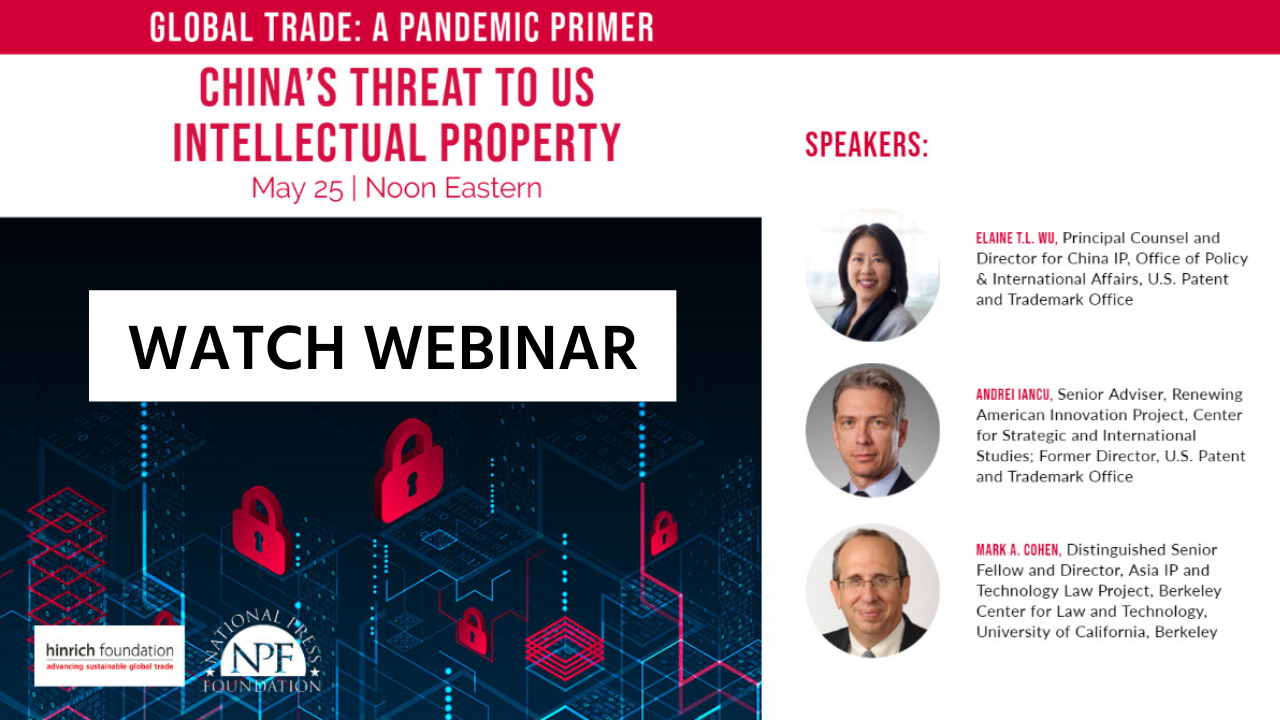China’s threat to US intellectual property
Published 01 June 2021
Intellectual property (IP) theft has been one of the most contentious issues in the US-China trade spat. What implications do IP theft have for national security and business operations? What do journalists need to be aware of when reporting on IP issues? In response to the US-China Phase One Agreement, what steps have China taken to better protect IP of foreign companies?
In this seventh installment of the Hinrich Foundation-sponsored National Press Foundation series on global trade, three IP experts were invited to share their insights on the issue of China's threat to American intellectual property. Read a summary of the five key takeaways:
- The FBI and other national security officials say China poses a substantial threat. FBI Director Christopher Wray calls it “the greatest long-term threat to our nation’s information and intellectual property, and to our economic vitality” and “theft on a scale so massive that it represents one of the largest transfers of wealth in human history.” Andrei Iancu, the former director of the US Patent and Trademark Office, said in a speech as he ended his tenure that “we must put an end to state-sponsored theft of intellectual property, and their cavalier attitude toward the proliferation of fakes and counterfeits.”
- IP theft includes a range of actions from counterfeiting to state-sponsored espionage. Iancu laid out a wide range actions that constitute of intellectual property theft: counterfeiting of goods from handbags to pharmaceuticals; government regulations, such as requiring US and other foreign companies to share tech secrets with their Chinese counterparts as a condition of access to the Chinese market; and criminal actions, including espionage by state agents or corporations. Mark Cohen of the University of California, Berkeley, detailed other types of IP that is being stolen.
- Reporters need to study up on the definitions of IP. Cohen said that US reporters often don’t fully understand the dimensions of IP theft, or even some of the basic definitions necessary to cover the issue. He shared the reporting on a case involving NBA legend Michael Jordan. “It was a case that went on in its various forms of dispute for perhaps a dozen or so years. The US media couldn’t get it right,” Cohen said. “Was it a copyright suit? Was it a name right suit? Was it a Chinese trademark battle? … US media is notorious for conflating, not discriminating patents, trademarks, copyrights, forced technology transfer, software piracy, copyright piracy — all these things have gotten commingled.”
- China is generating more of its own IP and has a massive apparatus for regulating it. The China National Intellectual Property Administration is the busiest of the five large patent offices worldwide, far outpacing the US Patent and Trademark Office and similar agencies in the European Union, South Korea and Japan. Less than 1% of nearly eight million trademark filings in China are from international entities. Elaine Wu, who tracks the issue for the US Patent and Trademark Office, said that China receives eight times as many patent applications as does her agency.
- While US companies have long complained about getting justice in China on IP issues, the Chinese system is changing. Wu said China has taken steps to enact or amend more than 60 IP regulations in response to what is known as the Phase One Agreement between the US and China. That said, it’s unclear whether and how China’s courts and agencies will implement and enforce the new regulations at the local level. Rights holders in China report that longstanding problems persist. “Chinese offenders are becoming adept at new methods of countering these enforcement mechanisms,” Wu said. “Some of China’s new approaches to address IP may actually raise more new problems.”
***
This briefing is part of a series of National Press Foundation's online webinars on global trade issues in the era of the coronavirus. Check here for all past briefings.
© The Hinrich Foundation. See our website Terms and conditions for our copyright and reprint policy. All statements of fact and the views, conclusions and recommendations expressed in this publication are the sole responsibility of the author(s).







